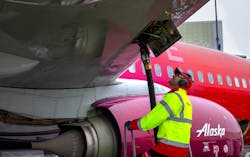The Aerospace Industry Needs Climate-Friendly Fuel. Can WA Help?
Snohomish County and Washington State University have partnered to establish a center in Everett, Washington, to help develop fuels that will allow the commercial aerospace industry to grow as carbon emissions restrictions begin to bite in the decade ahead.
The so-called sustainable aviation fuels, or SAF, are mostly distilled animal fats, cooking oil, inedible crops, wood debris or municipal waste. While such fuels still release greenhouse gases, their effects on the climate are much smaller than traditional aviation fuel.
The project is designed to boost efforts to begin large-scale SAF production — a goal that has consistently receded into the future.
At the announcement in Everett on Tuesday, Snohomish County Executive Dave Somers described the Paine Field Airport research and development center as "a critical element in moving forward with decarbonizing aviation," which he said is vital to the long-term viability of the region's aerospace industry and the global drive to address climate change.
State Sen. Mark Liias, whose district includes Paine Field, said SAF will bring not only sustainable aviation, but cleaner air around airports because it produces less soot than conventional fuel.
Though SAF has been hyped in the aviation world for at least five years, worldwide production of the fuel remains at a miniscule level relative to aviation's needs. Is this more hype?
Those promoting SAF say new federal funding and tax incentives, backed by state incentives in California and Washington, might finally provide the impetus for real progress in the United States.
Joshua Heyne, who has a joint appointment at WSU and Pacific Northwest National Laboratory directing bioproducts research, will run the R&D center. Heyne said new government policy is starting to drive momentum on SAF production.
"It's changing the amount of interest and investment very quickly," Heyne said.
Liias, chair of the Senate Transportation Committee, promised that the Legislature will align its tax policy, and its investment and partnership strategy, "to encourage investment by the private sector in sustainable aviation fuel here into the future." He inserted a clause in the proposed transportation budget that would provide $6.5 million for the new center.
Another bill sponsored by Senate Majority Leader Andy Billig will provide tax breaks for SAF facilities when production in the state exceeds 20 million gallons a year.
A SAF test center
Aircraft are currently powered by massive amounts of energy from burning fossil fuels. In response to climate change concerns, the airline industry has set a target of achieving "net zero" carbon emissions by 2050.
That's a colossal challenge.
Smaller aircraft can fly on electric batteries, but for planes the size Boeing builds the batteries would be too heavy. And, while hydrogen-powered aviation is being developed, it won't be available for large airliners that fly internationally until beyond 2050, if ever.
So the industry's proposed pathway to net zero relies on SAF for 65% of the decarbonization.
Unlike fossil fuels that release carbon previously locked in the earth for millennia, SAF is a renewable energy source from plants and animals. Though carbon dioxide still comes out of a jet engine burning SAF, that carbon has a short, renewable lifecycle.
Plants, including those grown as animal feed, absorb carbon dioxide from the air creating the hydrocarbons in oils, animal fats and human waste that are extracted to make SAF.
While it depends on the feedstock used and the method of extraction, Heyne said SAF produced commercially today has about one-fifth the climate effect of conventional jet fuel, from extraction to supply chain to burning the fuel.
As private companies around the globe come up with processes to produce SAF from different feedstocks, they must analyze their product to ensure it has similar chemical properties to conventional jet fuel.
With minimal changes to aircraft and infrastructure, it must flow through existing airport fuel tanks and pipes and burn inside today's jet engines in ways identical to regular jet fuel.
Part of Heyne's research is tweaking the chemistry to make it cleaner and yet retain the properties that allow it to "drop-in."
Inside a hangar at Paine Field, Heyne demonstrated how one proposed SAF produced considerably less sooty black smoke as it burned than a sample of regular jet fuel.
"The question ... we are laser-focused on is how do you minimize that soot, while maintaining all those drop-in properties," he said.
Any fuel for commercial flights must gain qualification by regulators as meeting aviation's strict safety specifications. For example, it must have a much higher ignition temperature than the gasoline you put in your car.
Heyne's WSU lab in the Tri-Cities tests small samples of SAF — a mere milliliter — from some three dozen companies around the globe that need their product independently validated.
The Paine Field center will scale up that research and testing of samples. Later, it will take hydrocarbon liquid processed from the raw feedstock and distill it into even larger quantities of SAF.
Heyne plans to have a 100-gallon distillation tower at Paine Field, and tanks that can hold tens of thousands of gallons.
Josh Dugan, Snohomish County executive operations officer, said several locations on Paine Field are being considered for the SAF center. He said the county will proceed with design of the facility this year and anticipates construction will take more than two years.
Little to show as yet
According to a Government Accountability Office report released in March, in 2019 — the last full year before the pandemic — U.S. commercial aircraft accounted for 2% of all greenhouse gas emissions in the U.S.
However, as air travel grows and ground transportation converts to cleaner modes, aviation's share of emissions is expected to grow.
The urgency of climate action is not matched by progress on SAF to date. Few SAF production plants are operating.
In southern Oregon, Red Rock Biofuels, which in 2013 and 2014 received $75 million in federal grants, collapsed before producing a drop of fuel when it failed to make payments on more than $300 million in debt.
The half-constructed Red Rock plant designed to produce SAF from forest waste is abandoned. An auction to sell it off in February was postponed.
And though Alaska Airlines in late 2016 celebrated the first commercial flight running partly on wood — a jet-fuel blend containing 20% SAF made from Pacific Northwest forest waste — last year the amount of SAF produced in the U.S. totaled less than 1% of the total fuel burned by U.S. airlines.
In 2012, the Federal Aviation Administration set a goal for U.S. airlines to use 1 billion gallons of SAF per year by 2018. They never got close.
Just two producers supply SAF commercially in the U.S.
World Energy and Neste provide SAF, respectively, to Los Angeles and San Francisco International Airports. In 2022, SAF production in the U.S. was less than 16 million gallons.
World Energy and Neste produce SAF from cooking oil and animal fats. The problem with that feedstock is scaling up production.
"There's not enough used cooking oil and beef tallow to scale to the problem for aviation," Heyne said.
Other feedstocks are being developed.
From a plant in Reno, Nevada, Fulcrum Bioenergy in February shipped to a refinery its first railcar of crude oil made from municipal waste.
The GAO report notes that Fulcrum — the only one of three 2014 government grant recipients to actually deliver any fuel — aims to produce its own SAF by 2025 or 2026.
Also in development is a process that will produce SAF from alcohol extracted from sugars and biomass, including ethanol.
Dale Smith, Boeing's regional director of environmental sustainability, said the industry will have to explore multiple avenues for SAF production to achieve the necessary scale.
"We're trying to replace petroleum," Smith said. "To do that, we're gonna have to have lots of everything ... a spectrum of feedstocks and conversion processes."
Government support to scale up
Inhibiting uptake of SAF is the cost of the fuel, which the GAO report cites as between two to eight times the cost of conventional jet fuel.
Various airlines eager to tout their green credentials have committed to purchase large amounts of SAF.
Last week, Alaska Airlines announced a partnership with oil giant Shell to "bring SAF to more markets, in greater quantities and at a more sustainable long-term cost." As part of the agreement, Shell will supply up to 10 million gallons of SAF to Alaska at its Los Angeles hub.
But the GAO report notes that, due to the cost and the lack of supply, previous agreements "have failed to result in actual SAF deliveries within the announced time frames," and have instead been replaced with new agreements for SAF purchases further in the future.
The small scale of SAF production is the immediate issue.
Michael Wolcott, WSU's director of alternative jet fuels research who led the project for that 2016 Alaska Airlines SAF flight, said the main barrier to production has been the lack of government support for huge, necessary infrastructure investments.
"The problem has always been strong, stable policy," he said. "We have not had strong policies that support this energy transformation, especially in the aviation sector, until this administration."
Last year, the White House set new goals to produce 3 billion gallons of SAF per year by 2030, and 35 billion gallons per year by 2050.
To goose the flagging industry, the 2022 Inflation Reduction Act included tax breaks for SAF production and $297 million in grants to producers and researchers.
Wolcott said that, plus state support in California and now in Washington state, has already produced a great uptick in announced projects.
"It has been a long hard struggle getting going on this," he said. "I do think that this has become a different situation now and is starting to take off."
He said his research team was asked by the Federal Aviation Administration to assess whether the new White House targets are achievable.
"The answer is 'yes,' " Wolcott said. "We've never been in a better situation than we are right now."
In the Northwest, two possible SAF production plants are being studied.
John Plaza, CEO of SkyNRG Americas, which has for several years been weighing where to locate a SAF production plant, said via email that Washington remains an option.
"Fundamentally, we still believe Washington is a highly attractive location for us to consider," said Plaza.
And BP Americas has identified its oil refinery at Cherry Point near Bellingham, Washington, as "a preferred location" for a SAF production facility. "Project teams at the refinery have already been working on the engineering and financials," said BP spokesperson Christina Audisho.
©2023 The Seattle Times. Visit seattletimes.com. Distributed by Tribune Content Agency, LLC.


